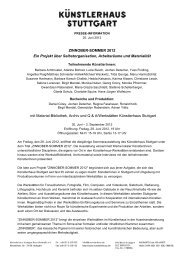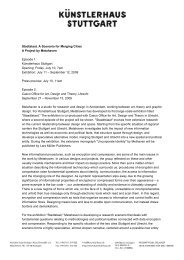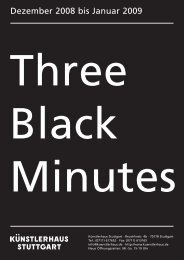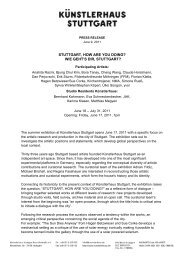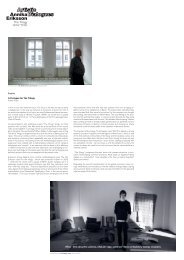Florian Zeyfang and Adnan Yildiz in conversation (English/pdf)
Florian Zeyfang and Adnan Yildiz in conversation (English/pdf)
Florian Zeyfang and Adnan Yildiz in conversation (English/pdf)
You also want an ePaper? Increase the reach of your titles
YUMPU automatically turns print PDFs into web optimized ePapers that Google loves.
<strong>English</strong><br />
THE IMMORTAL<br />
<strong>Florian</strong> <strong>Zeyfang</strong>: Stones (Archive), HD video, 110 m<strong>in</strong>., 2012<br />
A short <strong>in</strong>troduction for the solo exhibition project, “Stones/Ste<strong>in</strong>e” by <strong>Florian</strong> <strong>Zeyfang</strong><br />
<strong>Adnan</strong> <strong>Yildiz</strong><br />
Berl<strong>in</strong> based artist <strong>Florian</strong> <strong>Zeyfang</strong> has approached the format of solo exhibition at Künstlerhaus<br />
Stuttgart as a chance of develop<strong>in</strong>g a new body of work, which was conceived dur<strong>in</strong>g a longterm<br />
research process. Based on archive images from the collection of Stockholms Stadsmuseum<br />
- several thous<strong>and</strong> photos of numbered <strong>and</strong> registered stones - his new video confronts us not only<br />
with their ontological weight of be<strong>in</strong>g from a city that they are not a part of anymore, as such, but<br />
also they are absolute witnesses of human existence st<strong>and</strong><strong>in</strong>g much older than us; <strong>and</strong> are immortal.<br />
<strong>Zeyfang</strong> also presents other (mov<strong>in</strong>g) images of rocks that are part of a series of collections he<br />
undertook on recent travels. Between an established form of <strong>in</strong>stitutional archive <strong>and</strong> an artistic<br />
look on the stones the exhibition is built on their silence (of the stones), their potentiality of reflect<strong>in</strong>g<br />
on our existence as well as rem<strong>in</strong>d<strong>in</strong>g us the natural fact that we have all fallen on earth... As<br />
echoes from the history of philosophy, the images of stones - especially consider<strong>in</strong>g the way <strong>Florian</strong><br />
<strong>Zeyfang</strong> displays them - as the ma<strong>in</strong> actors of an almost two hour long film material made of a collection<br />
<strong>and</strong> projections of an ongo<strong>in</strong>g personal archive. Separately they refer to diverse systems,<br />
languages, <strong>and</strong> bodies, br<strong>in</strong>g<strong>in</strong>g a series of flashbacks; I recall the voice of archaeology <strong>in</strong> the present<br />
tense of the past.<br />
<strong>Florian</strong> <strong>Zeyfang</strong>: Pebbles (Isolation), slide projection, 81 slides, 2012<br />
Accord<strong>in</strong>g to Michel Foucault, an archive is someth<strong>in</strong>g left beh<strong>in</strong>d by a particular history <strong>and</strong>/or culture.<br />
It is a form of collect<strong>in</strong>g, <strong>and</strong> traces of any k<strong>in</strong>d of material can limit our perception of the time<br />
period that they belong to. Through the archive, one can deduce the historical a priori of the period<br />
or its episteme. In his Archaeology of Knowledge, Foucault makes it clear with his statement about<br />
how the archive surrounds our presence: “Between the language (langue) that def<strong>in</strong>es the system of<br />
construct<strong>in</strong>g possible sentences, <strong>and</strong> the corpus that passively collects the words that are spoken<br />
the archive def<strong>in</strong>es a particular level: that of a practice that causes a multiplicity of statements to<br />
emerge as so many regular events, as so many th<strong>in</strong>gs to be dealt with <strong>and</strong> manipulated. It does not<br />
have the weight of tradition; <strong>and</strong> it does not constitute the library of all libraries, outside time <strong>and</strong><br />
place; nor it is the welcom<strong>in</strong>g oblivion that opens up to all new speech the operational field of its<br />
freedom; between tradition <strong>and</strong> oblivion, it reveals the rules of a practice that enables statements<br />
both to survive <strong>and</strong> undergo regular modification. It is the general system of the formation <strong>and</strong> transformation<br />
of statements.” 1<br />
The collections of the stones loop <strong>in</strong> the dark filmic atmosphere of the exhibition space, where the<br />
audience is <strong>in</strong>vited to experience the abstracted form of the archive as a video <strong>in</strong>stallation, or projections<br />
that move from one frame <strong>in</strong>to another <strong>in</strong> silent existence. Even some of them are numbered,<br />
<strong>and</strong> others are still kept <strong>in</strong> their natural habitat, they still do not <strong>in</strong>dicate any <strong>in</strong>formation about their<br />
time period – an unusual quality for an archive. They are older than us, <strong>and</strong> they are younger than<br />
us at the same time. They have existed before us, <strong>and</strong> will surely exist after us. How long do we live?<br />
How old do we get? How do we age?<br />
What happens when the formation of the archive is based on someth<strong>in</strong>g that does not allow us to <strong>in</strong>dicate<br />
any time period for it, or even if it does, the material itself disproves of the association? When<br />
it is about the stones, time casts away. In front of them, we feel alike <strong>and</strong> different at the same time.<br />
The stones, or rocks are composed of m<strong>in</strong>erals <strong>and</strong> geology classifies, or names them accord<strong>in</strong>g<br />
to their orig<strong>in</strong>s, or the chemical composition that they have <strong>in</strong> their physical mass. Even if this does<br />
refer to a certa<strong>in</strong> time <strong>in</strong> its scientific context; it still does not say anyth<strong>in</strong>g about its future. Like <strong>and</strong><br />
unlike us, they are immortal.<br />
1<br />
Foucault, M., The Archaeology of Knowledge, London <strong>and</strong> New York: Routledge, 2002. p. 130.
An <strong>in</strong>terview with <strong>Florian</strong> <strong>Zeyfang</strong><br />
<strong>Adnan</strong> <strong>Yildiz</strong>: How would you <strong>in</strong>troduce yourself to the<br />
Stuttgart audience? Especially if they are familiar with<br />
your work as a curator regard<strong>in</strong>g the collaboration that<br />
took place at Künstlerhaus Stuttgart?<br />
<strong>Florian</strong> <strong>Zeyfang</strong>: Yes, there was an earlier appearance of m<strong>in</strong>e<br />
at the Künstlerhaus <strong>in</strong> 2007. The exhibition “1, 2, 3... Avantgardes”,<br />
orig<strong>in</strong>ally conceived by Lukasz Ronduda <strong>and</strong> myself for<br />
Warsaw, took place here <strong>in</strong> a smaller, ref<strong>in</strong>ed version thematically<br />
reshaped together with the previous artistic director, Axel Wieder.<br />
The focus <strong>in</strong> Stuttgart was on the architect Oskar Hansen <strong>and</strong><br />
his <strong>in</strong>fluence on art <strong>and</strong> experimental film, through his teach<strong>in</strong>g<br />
of the “Open Form” <strong>in</strong> the 1970s to young artists. His <strong>in</strong>fluence<br />
<strong>Florian</strong> <strong>Zeyfang</strong>: Rocks (Naturalism), slide projection, 70 slides, 2012<br />
lasts through today’s generation <strong>in</strong> Pol<strong>and</strong>, <strong>and</strong> when I came to<br />
Pol<strong>and</strong> with my <strong>in</strong>terest <strong>in</strong> experimental film <strong>and</strong> what it could<br />
mean for us today there was so much to discover - especially<br />
the ways experimental film <strong>and</strong> performance were used to shape<br />
counter public protests dur<strong>in</strong>g the Warsaw Block times. The “process-oriented<br />
approach” you mention ended up <strong>in</strong> a nonetheless<br />
thematically quite focused exhibition <strong>and</strong> book – at least I hope<br />
Lukasz <strong>and</strong> I managed to achieve someth<strong>in</strong>g specific...<br />
For an <strong>in</strong>troduction, I would have to go some years backwards, to<br />
expla<strong>in</strong> how this <strong>in</strong>terest <strong>in</strong> experimental film derived from the <strong>in</strong>tense<br />
five to seven years <strong>in</strong> Berl<strong>in</strong> after the wall fell <strong>and</strong> my work<br />
with filmmakers <strong>and</strong> artists <strong>and</strong> others <strong>in</strong> a group that didn’t want<br />
to be an artist group. There, we discussed – next to other th<strong>in</strong>gs<br />
– the mean<strong>in</strong>g of the many forms of documentarisms; then the<br />
Internet broadened the discussion on “media”. I went to New<br />
York <strong>in</strong> 1997 to make up for some miss<strong>in</strong>g <strong>in</strong>put <strong>in</strong> Berl<strong>in</strong>’s art<br />
education <strong>and</strong> there I was <strong>in</strong>troduced to many different ideas on<br />
art, text, <strong>and</strong> film, s<strong>in</strong>ce the fellow artists at the Whitney Independent<br />
Study Program came with so many different backgrounds.<br />
Dur<strong>in</strong>g <strong>and</strong> after the WISP, I was lucky to work with great people<br />
on two different shows, one with Annette Sch<strong>in</strong>dler on collective<br />
work, another one with her <strong>and</strong> Gareth James on Jean-Luc<br />
Godard <strong>and</strong> Anne-Marie Miéville’s TV <strong>and</strong> video work. For me<br />
this was a way to cont<strong>in</strong>ue the work between mak<strong>in</strong>g art by way<br />
of my own production, <strong>and</strong> by way of organiz<strong>in</strong>g exhibitions that<br />
were exactly the way we as artists liked them to be. This comb<strong>in</strong>ation<br />
of practices cont<strong>in</strong>ued, through my solo-work focus<strong>in</strong>g on<br />
<strong>in</strong>stallation-based <strong>and</strong> c<strong>in</strong>ematic film/video, <strong>and</strong> <strong>in</strong> the mak<strong>in</strong>g of<br />
exhibitions <strong>and</strong> books, the last one conceived with Mart<strong>in</strong> Ebner<br />
<strong>and</strong> titled “Poor Man´s Expression”.<br />
AY: For the show at the Künstlerhaus, we both agreed to<br />
work on a long-term project that you have not f<strong>in</strong>alized until<br />
now; so, the solo exhibition operates as an experiment,<br />
or even an open studio process based on three works with<br />
the same approach. Maybe you can tell us how your story<br />
with stones began?<br />
FZ: It is a relief <strong>and</strong> a restriction at the same time: that we decided<br />
to reject some other ideas of m<strong>in</strong>e, much more “content-based”<br />
<strong>and</strong>/or text related, <strong>and</strong> focused on the stones, an idea that has<br />
haunted me now for some time. You maybe want to describe<br />
yourself, how you see it like an open studio process, but I appreciate<br />
that we are somewhat have a l<strong>in</strong>k here to the “Open Form”<br />
exhibition we made about Oskar Hansen several years ago.<br />
I stumbled upon the stone images <strong>in</strong> Norway <strong>in</strong> 2010, <strong>and</strong> actually<br />
it was much more by way of my <strong>in</strong>terest <strong>in</strong> photography<br />
archives. So, <strong>in</strong> a way we discuss not only stones here, but also<br />
photography, or film that matter, s<strong>in</strong>ce all or most of the images<br />
<strong>in</strong> the show are <strong>in</strong> flux. But how or why make a film about someth<strong>in</strong>g<br />
as still as a stone? I th<strong>in</strong>k I have not found the answer<br />
yet, but your <strong>in</strong>vitation to <strong>in</strong>terpret the Künstlerhaus show as an<br />
experiment came at the right moment.<br />
In connection with a discussion about<br />
my earlier work <strong>and</strong> archives, I was <strong>in</strong>troduced<br />
to images from Stockholms<br />
Stadsmuseum through the photographer<br />
Fredrik Sweger. Thous<strong>and</strong>s of stones<br />
from the museum’s archive were shot by<br />
him, commissioned through an archiv<strong>in</strong>g<br />
process. Stones that were part of houses,<br />
bridges <strong>and</strong> palaces, etc., <strong>and</strong> are loaded<br />
with the history of a city that does not exist<br />
anymore <strong>in</strong> the same form now. Even<br />
though the people there were extremely<br />
helpful, it took me more then a year to get<br />
access to the images, <strong>and</strong> they are truly<br />
fasc<strong>in</strong>at<strong>in</strong>g, <strong>in</strong> the range of forms, colors<br />
<strong>and</strong> surfaces <strong>and</strong> with all the signals they<br />
send out. The archival look isolates them<br />
<strong>and</strong> detaches them but at the same time<br />
sets free the imag<strong>in</strong>ation. And obviously,<br />
they acquire an extremely sculptural presence<br />
that they would never have, shoved<br />
<strong>in</strong> between a wall <strong>and</strong> the street surface.<br />
The observation we experience now rem<strong>in</strong>ds me of Rusk<strong>in</strong>’s detailed<br />
description of the “Stones of Venice”, recorded through<br />
draw<strong>in</strong>gs <strong>and</strong> writ<strong>in</strong>gs <strong>in</strong> his famous notebooks. So, let’s call this<br />
the man-made side of stones, but aga<strong>in</strong>: they seem to be tell<strong>in</strong>g<br />
their own specific story by now.<br />
Now to a completely different story even though it comes by<br />
the same title. I realized that this was not the only th<strong>in</strong>g I was<br />
after, <strong>and</strong> became <strong>in</strong>terested <strong>in</strong> stones as such, <strong>in</strong> untouched<br />
stones. I photographed them <strong>in</strong> a very northern part on a trip<br />
from Sweden to Norway <strong>and</strong> collected them at the Baltic Sea.<br />
It felt very much like a German tourist, on both locations. And<br />
how to deal with this without gett<strong>in</strong>g esoteric or <strong>in</strong>to mysticism?<br />
Roger Caillois once activated the term “mysticism” for himself<br />
<strong>in</strong> quite a specific way, bas<strong>in</strong>g it on “matter” <strong>and</strong> the experience<br />
it <strong>in</strong>troduces, <strong>in</strong>stead of religion. He was well aware of the<br />
paradox. And for Francis Ponge <strong>in</strong> his fasc<strong>in</strong>at<strong>in</strong>g discussion of<br />
the “Th<strong>in</strong>gs”, among others, the pebble, it is important to avoid<br />
mysticism by way of nam<strong>in</strong>g the details one observes, <strong>and</strong> by<br />
chang<strong>in</strong>g the subject often, while ma<strong>in</strong>ta<strong>in</strong><strong>in</strong>g a certa<strong>in</strong> moderate<br />
distance... I feel I cannot really translate <strong>in</strong>to <strong>English</strong>, or even<br />
<strong>in</strong>to German, what I remember him writ<strong>in</strong>g <strong>in</strong> the “Introduction to<br />
a Pebble”. But he was try<strong>in</strong>g to establish an enclosed description<br />
of th<strong>in</strong>gs that I am only start<strong>in</strong>g to discover.<br />
“The pebble is not an easy th<strong>in</strong>g to def<strong>in</strong>e. If we content ourselves<br />
with a simple description, we can say first of all that it is a<br />
form or a state between a rock <strong>and</strong> a stone. But this proposition<br />
implies a notion of stone that must be justified. I don’t want to be<br />
accused here of go<strong>in</strong>g back even further than the Flood.” 1<br />
AY: In 2008, you made a video about the books that Walter<br />
Benjam<strong>in</strong> mentions <strong>in</strong> his lead<strong>in</strong>g article “A Short History<br />
of Photography” from 1931. In terms of consider<strong>in</strong>g an<br />
archive as a liv<strong>in</strong>g form or organic body, the relationship<br />
between that video <strong>and</strong> the recent project with stones<br />
br<strong>in</strong>g me to a clear po<strong>in</strong>t of view that you are <strong>in</strong>terested<br />
<strong>in</strong> the potentiality of politiciz<strong>in</strong>g the past, or are you? How<br />
would you talk about it?<br />
FZ: One would maybe talk first about “re-visit<strong>in</strong>g” the past, past<br />
ideas <strong>and</strong> images, <strong>and</strong> connect<strong>in</strong>g them to contemporary discussions.<br />
In the case of the Benjam<strong>in</strong> video, I returned to a text<br />
that once had left a huge impression on me <strong>and</strong> tried to f<strong>in</strong>d a<br />
way how to deal with it. Of course the quality of the text comes<br />
with his words, but I found it necessary to look at the same images<br />
<strong>and</strong> <strong>in</strong> the same form as Benjam<strong>in</strong> when he wrote the “Kle<strong>in</strong>e<br />
Geschichte der Photographie”. I found most of the books he<br />
mentioned <strong>in</strong> the first edition – basically like Benjam<strong>in</strong> saw them<br />
– <strong>and</strong> <strong>in</strong>troduced them through a rigorous formal frame <strong>in</strong>to the<br />
video. For me that was the only way to do it, to k<strong>in</strong>d of “neutrally”<br />
look through those images. In the second part this collection<br />
is confronted with fast images from today’s world, collected <strong>in</strong><br />
six “volumes” like places of production (film set <strong>and</strong> photo lab),<br />
places of projection (C<strong>in</strong>ema <strong>and</strong> TV), Mov<strong>in</strong>g <strong>and</strong> St<strong>and</strong>still, Inside<br />
<strong>and</strong> Outside. The six volumes corresponded with the six<br />
books that are the basis for Benjam<strong>in</strong>’s ideas.<br />
The simple form opens up for that many ways to read the video.<br />
Benjam<strong>in</strong> wrote the text before his famous “Artwork” essay, <strong>and</strong><br />
yet this was the moment when the form of look<strong>in</strong>g at art was<br />
turned <strong>in</strong>to book consummation – the first catalogues gave an<br />
overview of art history to maybe a privileged class, but still it was<br />
far more accessible to people. And it changed its form. Not yet<br />
considered an art form itself, it was photography that allowed<br />
this <strong>and</strong> photography became itself subject to such historic<br />
record<strong>in</strong>g <strong>and</strong> publication. Photography wrote <strong>and</strong> shaped its<br />
own historic appearance. Benjam<strong>in</strong> caught that moment, <strong>and</strong> so<br />
did others, but his <strong>in</strong>terest was maybe more embrac<strong>in</strong>g, with a<br />
love for the subject <strong>and</strong> the book <strong>and</strong> the place, its discussions<br />
marked them both historically <strong>and</strong> socially.<br />
In how far does this means “politiciz<strong>in</strong>g the past”? Maybe it is<br />
just a way to br<strong>in</strong>g back the political approach that Benjam<strong>in</strong><br />
used <strong>in</strong> writ<strong>in</strong>g this text; he had so many forms to do that. The<br />
“artwork <strong>in</strong> the age of reproduction” is the classic example, but<br />
regard<strong>in</strong>g my video “Introduction to a Short History of Photography”<br />
I have been asked more <strong>in</strong> direction of his “Passages”,<br />
the non-f<strong>in</strong>ished, giant collection of “convolutes” he left us with.<br />
(Many an artist <strong>and</strong> even more art historians have commented<br />
on, <strong>and</strong> used the Passages, <strong>and</strong> while this may be banal, they<br />
shall forever claim the right to do so.)<br />
This video was already much less carry<strong>in</strong>g an obvious political<br />
message than earlier work of m<strong>in</strong>e, where I traced back the role<br />
of media <strong>in</strong> relation to politics, to revolutions, to social responsibilities.<br />
One obvious sign is that here, the text level is reduced<br />
to a mere <strong>in</strong>troduction of what follows, <strong>and</strong> then just images<br />
are shown. They carry the politics of their time, <strong>and</strong> Benjam<strong>in</strong>’s,<br />
<strong>and</strong> they trigger a contemporary reaction. The collection of the<br />
archival stones I am show<strong>in</strong>g here now comes without any text<br />
<strong>in</strong> the video, <strong>and</strong> there is no sound either – how would it be<br />
ever political, <strong>and</strong> then, look<strong>in</strong>g at the stories these leftovers<br />
<strong>and</strong> bricks <strong>and</strong> columns <strong>and</strong> lions <strong>and</strong> monsters are tell<strong>in</strong>g, how<br />
can it not?<br />
Through the projects <strong>in</strong> the last years, I have been <strong>in</strong>troduced<br />
to many forms of the mak<strong>in</strong>g of mov<strong>in</strong>g images <strong>and</strong> the experiments<br />
of the past, as different as the abstract films of Oskar<br />
Fisch<strong>in</strong>ger <strong>and</strong> his contemporaries, or Dziga Vertov’s newsreels.<br />
Cuban film told me a lot, both the films they love <strong>and</strong> those they<br />
did not love. Then it was the history of experimental film <strong>and</strong><br />
there, especially the experiences <strong>in</strong> Pol<strong>and</strong>, that showed me<br />
how formal experiments can be <strong>in</strong>tensely political. And through<br />
“Poor Mans’s Expression”, the title says it, we discussed the reasons<br />
<strong>and</strong> ideas beh<strong>in</strong>d the use of poor means <strong>in</strong> film, video <strong>and</strong><br />
other media, a very important issue, <strong>and</strong> political <strong>in</strong> itself. For<br />
my personal approach, the stone works are an experiment to<br />
reduce even more, to work more “poor” than before <strong>in</strong> terms of<br />
form, but not <strong>in</strong> terms of content.<br />
Thanks to Fredrik Sweger, Petter Smedberg, Clemens Krümmel<br />
<strong>and</strong> Judith Hopf<br />
1<br />
Francis Ponge.<br />
Schedule:<br />
Saturday, March 17, 2012, 7pm-2am<br />
LANGE NACHT DER MUSEEN<br />
Exhibitions <strong>and</strong> workshops at Künstlerhaus are open.<br />
Wednesday, March 21, 2012, 6pm<br />
Curatorial Exhibition Tour with <strong>Adnan</strong> <strong>Yildiz</strong><br />
Thursday, April 19, 2012, 7pm<br />
“Th<strong>in</strong>k<strong>in</strong>g Like A Stone”<br />
Lecture by Clemens Krümmel <strong>and</strong> film screen<strong>in</strong>g<br />
Clemens Krümmel will provide an illustrated analysis of several motives from<br />
the Japanese film “Nowhere Man” as well as talk about the aesthetics of enlivened<br />
stones by show<strong>in</strong>g clips from other films <strong>and</strong> works.<br />
After the lecture, the film “Nowhere Man” will be shown. It is centered on a manga<br />
artist who chooses to quit his commercialised profession <strong>and</strong> starts to run a<br />
stone shop. „Nowhere Man“ is the direction debut of actor Naoto Takenaka. It is<br />
based on a famous manga by Yoshiharu Tsuge <strong>and</strong> was awarded the Fipresci<br />
prize at the Venice Film Festival <strong>in</strong> 1991.<br />
„Nowhere Man“ („Muno no hoto“)<br />
Japan 1991, Japanese with <strong>English</strong> subtitles, 107 m<strong>in</strong>, director <strong>and</strong> lead<strong>in</strong>g<br />
role: Naoto Takenaka



